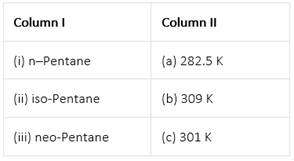Class 11 Exam > Class 11 Questions > Match the hydrocarbons in Column I with the ...
Start Learning for Free
Match the hydrocarbons in Column I with the boiling points given in Column II.

- a)(i) → (b) (ii) → (c) (iii) → (a)
- b)(i) → (a) (ii) → (c) (iii) → (a)
- c)(i) → (c) (ii) → (c) (iii) → (a)
- d)(i) → (d) (ii) → (c) (iii) → (a)
Correct answer is option 'A'. Can you explain this answer?
Verified Answer
Match the hydrocarbons in Column I with the boiling points given in C...
(i) n–Pentane: In n-pentane there is no branching and surface area. Hence , more Vander Waal's forces. Therefore , boiling point is high.
(ii) iso-Pentane: Molar mass is same but one branch is there which reduces its surface area. Hence the boiling point is less.
(iii) neo-Pentane: In this compound two sides chain are there having the same molar mass. Therefore , its boiling point is lowest amongst all three compounds.

|
Explore Courses for Class 11 exam
|

|
Similar Class 11 Doubts
Question Description
Match the hydrocarbons in Column I with the boiling points given in Column II.a)(i) → (b) (ii) → (c) (iii) → (a)b)(i) → (a) (ii) → (c) (iii) → (a)c)(i) → (c) (ii) → (c) (iii) → (a)d)(i) → (d) (ii) → (c) (iii) → (a)Correct answer is option 'A'. Can you explain this answer? for Class 11 2025 is part of Class 11 preparation. The Question and answers have been prepared according to the Class 11 exam syllabus. Information about Match the hydrocarbons in Column I with the boiling points given in Column II.a)(i) → (b) (ii) → (c) (iii) → (a)b)(i) → (a) (ii) → (c) (iii) → (a)c)(i) → (c) (ii) → (c) (iii) → (a)d)(i) → (d) (ii) → (c) (iii) → (a)Correct answer is option 'A'. Can you explain this answer? covers all topics & solutions for Class 11 2025 Exam. Find important definitions, questions, meanings, examples, exercises and tests below for Match the hydrocarbons in Column I with the boiling points given in Column II.a)(i) → (b) (ii) → (c) (iii) → (a)b)(i) → (a) (ii) → (c) (iii) → (a)c)(i) → (c) (ii) → (c) (iii) → (a)d)(i) → (d) (ii) → (c) (iii) → (a)Correct answer is option 'A'. Can you explain this answer?.
Match the hydrocarbons in Column I with the boiling points given in Column II.a)(i) → (b) (ii) → (c) (iii) → (a)b)(i) → (a) (ii) → (c) (iii) → (a)c)(i) → (c) (ii) → (c) (iii) → (a)d)(i) → (d) (ii) → (c) (iii) → (a)Correct answer is option 'A'. Can you explain this answer? for Class 11 2025 is part of Class 11 preparation. The Question and answers have been prepared according to the Class 11 exam syllabus. Information about Match the hydrocarbons in Column I with the boiling points given in Column II.a)(i) → (b) (ii) → (c) (iii) → (a)b)(i) → (a) (ii) → (c) (iii) → (a)c)(i) → (c) (ii) → (c) (iii) → (a)d)(i) → (d) (ii) → (c) (iii) → (a)Correct answer is option 'A'. Can you explain this answer? covers all topics & solutions for Class 11 2025 Exam. Find important definitions, questions, meanings, examples, exercises and tests below for Match the hydrocarbons in Column I with the boiling points given in Column II.a)(i) → (b) (ii) → (c) (iii) → (a)b)(i) → (a) (ii) → (c) (iii) → (a)c)(i) → (c) (ii) → (c) (iii) → (a)d)(i) → (d) (ii) → (c) (iii) → (a)Correct answer is option 'A'. Can you explain this answer?.
Solutions for Match the hydrocarbons in Column I with the boiling points given in Column II.a)(i) → (b) (ii) → (c) (iii) → (a)b)(i) → (a) (ii) → (c) (iii) → (a)c)(i) → (c) (ii) → (c) (iii) → (a)d)(i) → (d) (ii) → (c) (iii) → (a)Correct answer is option 'A'. Can you explain this answer? in English & in Hindi are available as part of our courses for Class 11.
Download more important topics, notes, lectures and mock test series for Class 11 Exam by signing up for free.
Here you can find the meaning of Match the hydrocarbons in Column I with the boiling points given in Column II.a)(i) → (b) (ii) → (c) (iii) → (a)b)(i) → (a) (ii) → (c) (iii) → (a)c)(i) → (c) (ii) → (c) (iii) → (a)d)(i) → (d) (ii) → (c) (iii) → (a)Correct answer is option 'A'. Can you explain this answer? defined & explained in the simplest way possible. Besides giving the explanation of
Match the hydrocarbons in Column I with the boiling points given in Column II.a)(i) → (b) (ii) → (c) (iii) → (a)b)(i) → (a) (ii) → (c) (iii) → (a)c)(i) → (c) (ii) → (c) (iii) → (a)d)(i) → (d) (ii) → (c) (iii) → (a)Correct answer is option 'A'. Can you explain this answer?, a detailed solution for Match the hydrocarbons in Column I with the boiling points given in Column II.a)(i) → (b) (ii) → (c) (iii) → (a)b)(i) → (a) (ii) → (c) (iii) → (a)c)(i) → (c) (ii) → (c) (iii) → (a)d)(i) → (d) (ii) → (c) (iii) → (a)Correct answer is option 'A'. Can you explain this answer? has been provided alongside types of Match the hydrocarbons in Column I with the boiling points given in Column II.a)(i) → (b) (ii) → (c) (iii) → (a)b)(i) → (a) (ii) → (c) (iii) → (a)c)(i) → (c) (ii) → (c) (iii) → (a)d)(i) → (d) (ii) → (c) (iii) → (a)Correct answer is option 'A'. Can you explain this answer? theory, EduRev gives you an
ample number of questions to practice Match the hydrocarbons in Column I with the boiling points given in Column II.a)(i) → (b) (ii) → (c) (iii) → (a)b)(i) → (a) (ii) → (c) (iii) → (a)c)(i) → (c) (ii) → (c) (iii) → (a)d)(i) → (d) (ii) → (c) (iii) → (a)Correct answer is option 'A'. Can you explain this answer? tests, examples and also practice Class 11 tests.

|
Explore Courses for Class 11 exam
|

|
Signup to solve all Doubts
Signup to see your scores go up within 7 days! Learn & Practice with 1000+ FREE Notes, Videos & Tests.





















